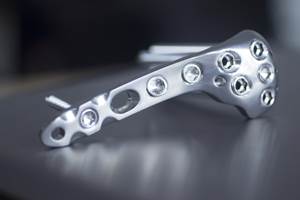Keep it Clean and Stainless
To prevent parts from recontamination, encapsulate or cover the unloading area of the cleaning machine.
Not many people will object that the cleanliness of parts has become a decisive quality criterion in precision parts manufacturing. Thus, companies invest money and time into achieving the cleanliness specifications demanded by their customers.
But as soon as the parts leave the machine, there is a risk of recontamination, caused by dust, tiny particles and everything else that can be found in the air of the production environment. Another danger is rusting, at least for parts made from materials susceptible to corrosion, such as steel and cast iron. Think about the distances parts travel by road, air or sea before they reach their final destination. They are manufactured at one location, then shipped, for example, to a heat treatment shop or job shop coater and further on to an assembly plant. They often travel from one continent to another for thousands of miles.
To prevent parts from recontamination, encapsulate or cover the unloading area of the cleaning machine. This helps keep cleaned parts clean when packaging and storage is performed in a “clean zone”—an area where no grinding dust and particulates are stirred up.
Then, even if the transport containers are only used to carry cleaned parts from one machining step to the next, they don’t remain clean forever. They should also be subject to regular cleaning. Short storage times between individual machining steps contribute to keeping the parts clean and corrosion-free. However, as this cannot always be ensured, temporary corrosion protection has become part and parcel of parts manufacturing, as well as being indispensable for travelling or long-term parts storage.
Often, the process of putting the parts into a box and pouring oil over them is used for long-term parts storage. Although this method is easy and fast, it is not effective. The oil primarily protects external surface areas and doesn’t reach internal areas, especially parts with complex geometries. Including the application of the preservative in the cleaning process is much more effective and protective. In this case, like with the cleaning media, it reaches the external and internal areas of the parts.
Short-term corrosion protection for several hours or days is often carried out in aqueous cleaning systems with a water-based cleaning agent containing amines. In case a longer protection time is required, a separate passivation bath can be employed. Depending on the amine and concentration, a protection period of several weeks can be achieved. Emulsified oils are also used for temporary aqueous corrosion protection. These can prolong the protection time for months. With these substances, the protective layer on the parts surface is created from a two-phase system (water and oil). This can lead to non-homogenous protective films and spot development.
A trend I have noticed over the last few years is to perform corrosion protection in fully closed vacuum solvent cleaning systems with oils, greases or waxes, which are completely soluble in the solvent. The solvent cleaning system is then equipped with an additional tank, only used for the corrosion protection process. This tank contains the solvent, for example, hydrocarbon, modified alcohol or perchloroethylene, and the required amount of corrosion protection media. After the parts are cleaned, the machine’s work chamber is flooded with media from the corrosion protection tank. As with the cleaning process, all areas of the parts are reached.
During the subsequent vacuum drying process, the solvent is transported back to the corrosion protection tank while the protective film remains on the part surface. Sometimes the solvent system is only used for corrosion protection after an aqueous cleaning process, for example, parts cleaning after thermal deburring in a water-based system followed by the corrosion protection step in a solvent system with one tank. The achievable protection time is weeks or months, even up to years, depending on the media concentration.
The fact that this corrosion protection method is fully automated, environmentally sound and is an easy process that is homogenous, completely closed and leaves a dry layer on the part’s surface might be why it is increasingly popular.
The job is not only done by achieving the required cleanliness. This cleanliness also has to be maintained until the parts arrive at their final destination.
Related Content
In-line Monitoring for Automated Immersion Cleaning Systems
Ecoclean’s Acoustic Performance Measurement (APM) system provides in-line measurement of ultrasonic frequency and power in fully automated immersion cleaning systems on a batch-by-batch basis or at defined time intervals, such as once a shift, day or week.
Read MoreCool Clean’s Omega 1500 Provides Powerful, Portable Cleaning
PMTS 2023: By selecting the appropriate nozzle and making the necessary propellant pressure and temperature adjustments, the Omega 1500 can clean to a variety of surface cleanliness levels.
Read MoreKyzen Solvents Provide Ease of Cleaning for Medical Parts
The Metalnox line of solvent products are designed to improve reliability and increase the ease of cleaning in vacuum and vapor degreasing processes.
Read MoreVersatile Sandblasting for Deburring Intricate Geometries
PMTS 2023: Comco’s MicroBlasting sandblasting systems can deburr, texture and clean small, intricate parts.
Read MoreRead Next
Do You Have Single Points of Failure?
Plans need to be in place before a catastrophic event occurs.
Read MoreA Tooling Workshop Worth a Visit
Marubeni Citizen-Cincom’s tooling and accessory workshop offers a chance to learn more about ancillary devices that can boost machining efficiency and capability.
Read More5 Aspects of PMTS I Appreciate
The three-day edition of the 2025 Precision Machining Technology Show kicks off at the start of April. I’ll be there, and here are some reasons why.
Read More












.jpg;maxWidth=300;quality=90)









